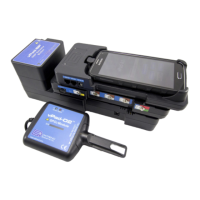vPad-A1 OPERATORS MANUAL
4.5.2.3 Intra-Uterine Pressure
Fetal monitoring devices measure Intra-Uterine Pressure (IUP) with invasive
pressure probes similar in principle to IBP sensors. When the IUP option is
selected from the upper list of the simulation menu, the module generates
dynamic pressure signals which are synchronized to a Fetal ECG waveform.
Together, the IUP and ECG signals represent the physiological state of a
neonate during labour contractions.
Touching the second dropdown list shows all applicable parameters:
Pressure-ECG Timing, Pressure Waveform, and Contraction Frequency.
Note
: When IUP is active, the module overrides the normal ECG settings to output a special Fetal
ECG
waveform. Attempts to change ECG settings will have no effect until a different IBP
simulation (Static or Dynamic) is selected.
Pressure-ECG Timing selects a pre-defined synchronization pattern which is
then used for the current simulation. When vPad-A1 generates an IUP
waveform, it also changes the pulse Rate of Fetal ECG so that the fetal
monitor can plot a “rate waveform/trend” that has the same period as the
pressure wave. Depending on the active Pressure-ECG Timing pattern, the
“rate waveform” drop may lead or lag peak of the IUP pressure wave, or the
Rate may increase or decrease from the starting Rate.
The Pressure Waveform setting controls the peak height of the pressure
waveform. Available options are 50 mmHg and 90 mmHg.
The
Contraction Frequency setting controls the length of time between the
start of each contraction pressure wave: 2 minutes, 3 minutes, or 5 minutes.
If the “Single Contraction” option is chosen instead, users must manually
start each contraction by pressing the button.
Figure 60
Figure 61
Figure 62
Manual Operation/Chapter 4 # Page 49

